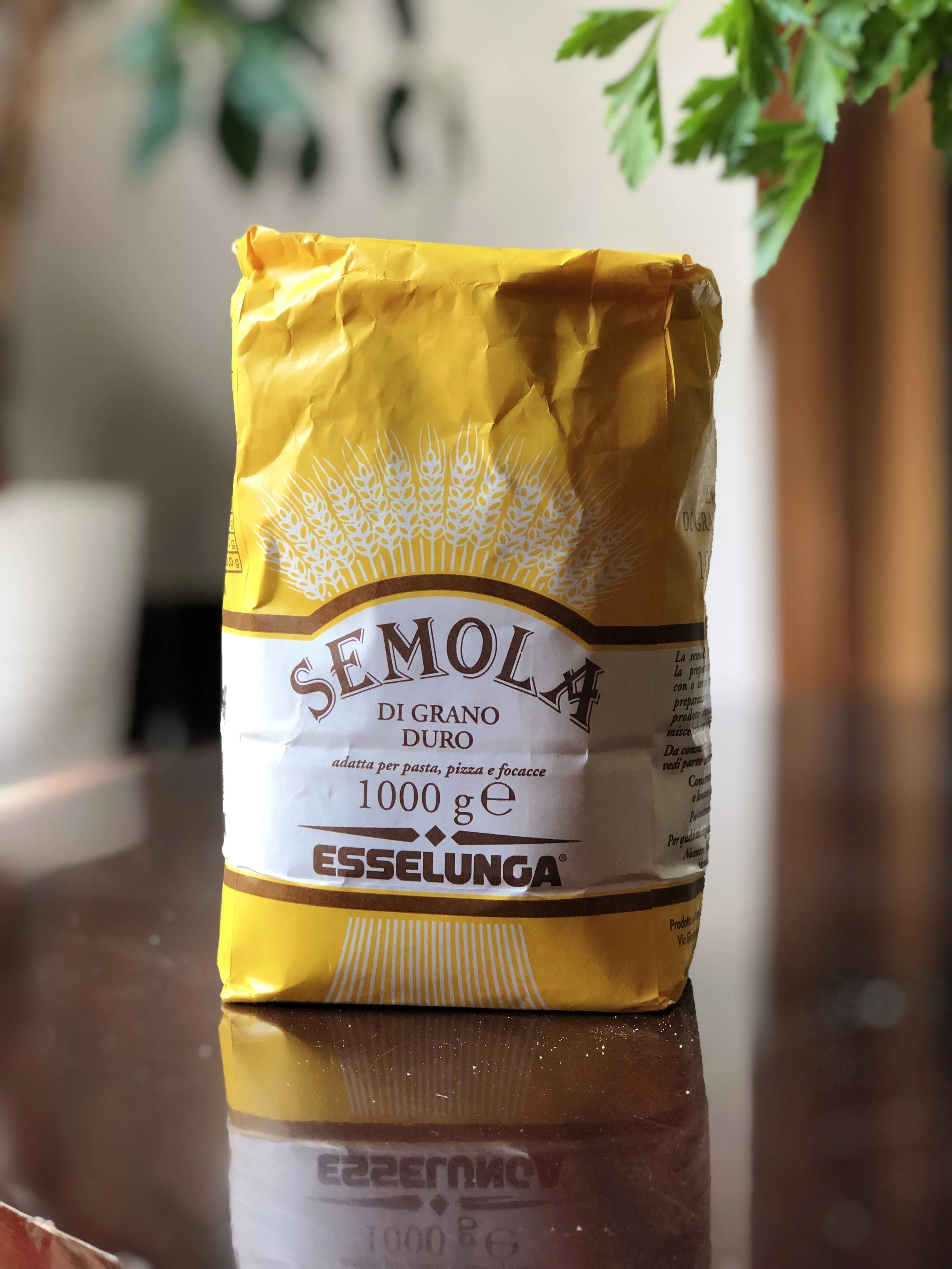Ingredient Substitutions
/Last Updated: October 4, 2025
In light of the recent Ingredient Substitutions in Italy post, I realized I could easily write another master list for common and easy ingredient substitutions, more geared for cooking and baking in the USA.
I know that I am often making one or more modifications in a recipe each time I’m in the kitchen. It’s part of the beauty of baking and cooking. Sometimes it comes out of necessity, other times it’s simply a desire to. Maybe I don’t have buttermilk, but I know I can use milk + lemon juice. A cookie recipe might call for butter, but maybe I’ll use oil instead if I forgot to soften butter or prefer a slightly healthier cookie. A lot of these I do without thinking, others I’m always having to look up to remember the quantity or ratio.
Here is an ingredient substitution list I’ve been working on, although far from comprehensive, these are some of the ones I find myself needing to do most often, or a few that saved me just once or twice in a pinch that I have never forgotten and am forever grateful for!
New York Times has an interesting list of ingredients substitutes, cuts of meat, herbs and their classes by taste and how to properly substitute them. Different kinds of substitutions, equally interesting!
I will continue to add to this list as I think of and learn new ones!
Use discretion when making substitutions. The kitchen is a wonderful place for experiments, but not all recipes can handle substitutions.
This post may contain affiliate links. If you make a purchase using these links, Jennyblogs may receive a small commission, at no extra cost to you. This helps to support Jennyblogs. Where possible, links are prioritized to small businesses and ethically and responsibly made items. For further information see the privacy policy. Grazie!
Baking Soda - you can use baking powder.
Baking powder isn’t as powerful as baking soda, so it’s recommended to use 3x the amount. For example, for 1 tsp of baking soda, add instead 3 tsp of baking powder. In higher amounts this can lead to an unusual, bitter taste from the baking powder, just so you know.
Broth - use bouillon cubes, powdered broth, or even just water, if the recipe calls for small amounts like 1/4 or 1/2 cup of broth. Reference the package or container for appropriate amount of bouillon or powdered broth to use.
Using powdered broth comes in handy so you don’t have to open a container of liquid broth and have the rest go to waste. Bouillon cubes you generally need to make at least 1 cup of broth per cube. I love powdered broth as a sub for small amounts of broth, as it is customizable. Just be wary, many powdered broths and bouillon cubes contain sketchy ingredients, including monosodium glutamate. Similar to real broth, both of these substitutes can be very high in sodium, so I usually suggest not adding in any extra salt to the recipe until you’ve tasted it with all broth or broth substitutes added in.
A new one I’ve found, is this Better Than Bouillon. They have many different flavors, some are organic. You can find better prices at Costco but here is an idea on Amazon:
Brown sugar - for every 1 cup of brown sugar, take 1 cup white granulated sugar and blend with 1 Tbsp of molasses. A food processor works well, if not mix well by hand.
Butter - use oil, coconut oil, margarine, shortening, or lard.
Oil: for every 1 cup of butter, add 3/4 cup of oil. Some say to use 7/8 cup of oil, but I will tell you that I grew up replacing 1 cup of butter with 3/4 cup of oil. It’s an easier amount to work with and works well!
Coconut oil: use an equal amount (1:1 ratio)
Margarine: use an equal amount (1:1 ratio)
Shortening: use an equal amount (1:1 ratio)
Lard: use 7/8 cup lard for every 1 cup of butter
You can sub applesauce for butter in baked goods, see “oil” below.
Buttermilk - for every 1 cup of buttermilk, add 1 Tbsp of lemon juice or any kind of baking vinegar (apple cider vinegar, white vinegar, etc.) to a measuring cup and fill to the 1 cup measure line with regular milk.
Cake flour - Take 1 cup of flour, remove 2 Tbsp of flour and add 2 Tbsp of cornstarch.
Canned Green Chilies - use a fresh pepper instead.
I like to sub 1-2 jalapeño or other spicy peppers for 1 can. Fresh tastes better, too! Canned chilies aren’t usually too spicy, so you‘ll want to remove the seeds from fresh hot peppers to reduce the spiciness.
Cream cheese - mascarpone can be a good sub for cream cheese in equal amounts.
Corn syrup - depending on the recipe, you can use honey or water and sugar.
Use an equal amount of honey for corn syrup. For sugar/water substitute, use 4 parts sugar and 1 part sugar. Meaning, if a recipe calls for 1 cup of corn syrup, use 1 cup of sugar and 1/4 cup of water.
Eggs - you can use a flax egg or chia egg.
Mix together 1 Tbsp flaxmeal or chia seeds with 3 Tbsp water. Mix well, and let sit in fridge until thickened and gloopy, about 15 minutes. This will replace 1 large egg.
Flour, self-rising - for every 1 cup of self-rising flour use 1 cup all-purpose flour with 1 tsp baking powder, 1/2 tsp salt, and 1/4 tsp baking soda.
Garlic - garlic granules or powder can be substituted for fresh garlic, or vice versa. 1/8 tsp of garlic POWDER or 1/4 tsp of garlic GRANULES is supposed to be equivalent to 1 clove of garlic.
Ginger - Fresh ginger and ground ginger can be swapped out for one another.
There is no hard and fast rule for the amount, unfortunately. You can use as little as 1/4 tsp ground ginger for every 1 Tbsp of fresh grated ginger, or as much as 1 1/2 tsp ground ginger for every 1 Tbsp grated fresh ginger called for.
Herbs - You can swap out fresh herbs for dried herbs, or vice versa. The general rule of thumb is to use 3x the amount of fresh as dried, as dried is usually stronger. i.e. if a recipe calls for 1/2 tsp dried thyme, you could use 1 1/2 tsp fresh thyme. Or if a recipe calls for 1 Tbsp (3 tsp) fresh oregano, you could swap out for 1 tsp dried oregano. I personally don’t think all herbs are equal when fresh or dried, one of the biggest being basil. I don’t think that dried basil should be substituted for fresh. If a recipe calls for dried basil, that’s fine, but I think the taste between fresh and dried are very distinct.
Honey - use equal amounts of maple syrup, agave nectar, or even sugar, brown sugar, etc.
Maple Syrup - use equal amounts of honey, agave nectar, sugar, brown sugar, etc.
Mayonnaise - use equal amounts of plain yogurt or sour cream.
Oil - use butter or any of the fats above under butter, or applesauce.
Butter: When subbing oil for butter it’s a bit more straightforward, oil is oil and doesn’t need to be whipped. When subbing butter for oil, if you’re making cookies, cake, quick breads, in most cases you’ll want to cream the butter until light and fluffy (about 3-5 minutes). Not to say you can’t make a delicious chocolate chip cookie with melted butter, you absolutely can, but it will be different than a cookie made with creamed butter.
or
Applesauce: This can be a cheaper and healthier alternative to oil. Since even unsweetened applesauce is naturally sweet, you can also reduce sugar in recipes when using this substitution. This substitution does take a bit of experimenting, especially if swapping out for larger quantities of oil, and doesn’t suit all recipes.
Onion - shallots, green onions, and leeks can all be interchanged for one another.
You can also use about 1 Tbsp onion powder for every 1 cup diced onion, this can be adjusted according to taste.
Peanut Butter - yes, you CAN use natural peanut butter!
Many desserts that call for peanut butter specify to use creamy, not natural, peanut butter, since natural peanut butter has a tendency to separate. But you know what? I have yet to find a pie, cookie, or other peanut butter dessert where I couldn’t use natural peanut butter. Do be mindful of over-stirring/beating, as this is what can often get you into trouble with the peanut butter separating.
Salt - No, there’s no substitute for salt really, but have you ever wondered why some recipes specify what kind of salt? For example, if a recipe calls for kosher salt? Why? Can’t you just use table salt?
Yes, of course you can. But it’s also handy to know that 1 tsp of different kinds of salt will lend different levels of salt to your dish. 1 tsp of Kosher salt is not quite as salty as 1 tsp of table salt, but it’s saltier than 1 tsp coarse sea salt. Why? Different kinds of salt pack into measuring spoons differently. More tiny grains of table salt fit into a teaspoon than coarser kosher or sea salt. So if you’re using table salt instead of kosher salt, you will want to use less, especially in larger quantities.
If all of that sounded like mumbo jumbo to you, that’s ok. Here’s a cheat sheet for swapping out salts, but you’ll probably only notice in larger quantities. Salt is personal, anyway. When in doubt, start with less. You can always taste and add more as needed, but you can’t un-salt a dish.
1 tsp of table salt = 1 tsp fine sea salt = 1 1/4 tsp coarse kosher salt = 2 tsp of fine kosher salt
Sour cream - use an equal amount of plain yogurt!
It’s also a healthier alternative.
Tomatoes - Fresh tomatoes and canned tomatoes can often be interchanged in cooking. For example, if a soup calls for a 14.5oz can of diced tomatoes, you could use instead 3 ripe medium tomatoes. You will probably need to adjust the cooking time to allow more time for the fresh tomatoes to break down. Similarly, you can use a can of tomatoes instead of fresh tomatoes, where appropriate.
Tomatoes (canned varieties) - Have you ever felt confused by the seemingly myriad varieties of canned tomatoes, and wondered what the difference is? I certainly have. There is diced, crushed, whole, plum, San Marzano, tomato paste, passata, fire roasted, tomato sauce, prepared sauces, etc. etc. But can you use them interchangeably? Easy answer is yes, but it helps to be familiar with their forms and what your actual preferences are for eating tomatoes in a recipe.
For example, if you’re making a tomato sauce for pasta, and the recipe calls for crushed tomatoes, you can absolutely sub in diced tomatoes instead. If, however, you don’t want chunks of tomatoes in your sauce, and you know that diced tomatoes are bigger chunks than crushed, then you can choose to blend your sauce in a blender or use an immersion blender to get your smooth, not chunky, pasta sauce.
That said, here is a quick cheat sheet for canned tomatoes and their consistencies, from smoothest to chunkiest:
Passata di pomodoro - a tomato purée, the smoothest of canned tomatoes. I have a harder time finding this in the States, but it is one of the more plentiful tomato products you can find in an Italian grocery store, as it is so often used in their cooking. I also enjoy paying .70cents for it in Italy vs $4 in the States. :)
Tomato sauce - another smooth purée, but often with a few added ingredients, such as basil, salt, garlic. Depending on your recipe, these may already be ingredients called for (since they so often go with tomatoes) and may not matter. Just pay attention to the salt, since tomato sauce often does have some salt and the recipe could end up saltier than anticipated.
Tomato paste - smooth, thick, tomato concentrate. Water can be added to reconstitute it, other times recipes call for tomato paste as is to be added. This adds richness to the tomato flavor of the recipe, even if fresh or canned tomatoes are already called for.
Crushed tomatoes - a little chunkier, maybe “lumpier” than passata, but still quite smooth. Once in a recipe I don’t usually notice any tomato “chunks.”
Diced tomatoes - Still saucy, but now with chunks of tomatoes. Maybe one of the most common types of canned tomatoes I see called for in US recipes.
Whole tomatoes - well, they’re whole! Usually peeled. You can slice or dice them for sauces, soups, etc., or add them to a blender or blend with an immersion blender for a smooth sauce.
Whole plum tomatoes - this is a kind of tomato. They’re medium, oblong, with a rich, juicy flavor great for making sauces. Some well-known varieties include Roma and San Marzano.
San Marzano tomatoes - these are a prized, production protected, type of Italian plum tomato. They can be found in the various forms, passata, crushed, whole, etc. You can often find them imported in cans straight from the Campania region of Italy, from where they originally hail. This makes them pricey, but you can also find them in American plant nurseries or in seed form to grow yourself.
Fire roasted tomatoes - tomatoes with a distinct smoky flavor, usually in diced form. Really delicious in soups, especially Mexican inspired ones such as enchilada or tortilla soup.
Tomatoes with green chilies - diced tomatoes with diced green chilies, for when you want both in a recipe. I rarely buy this since I like to have cans of green chilies on hand, or I just use a fresh pepper, such as jalapeño, instead.



































